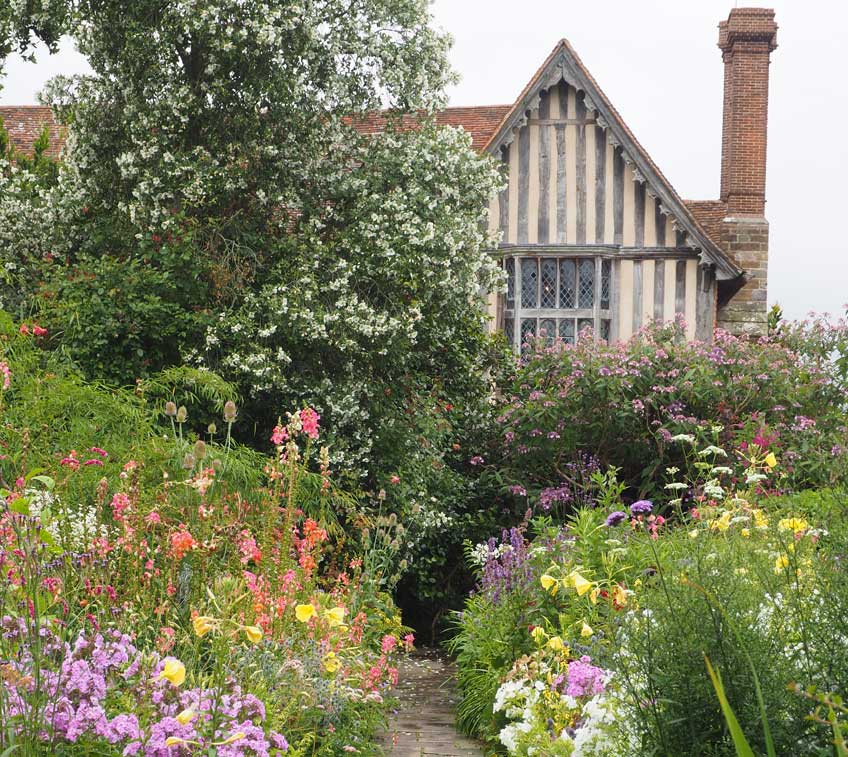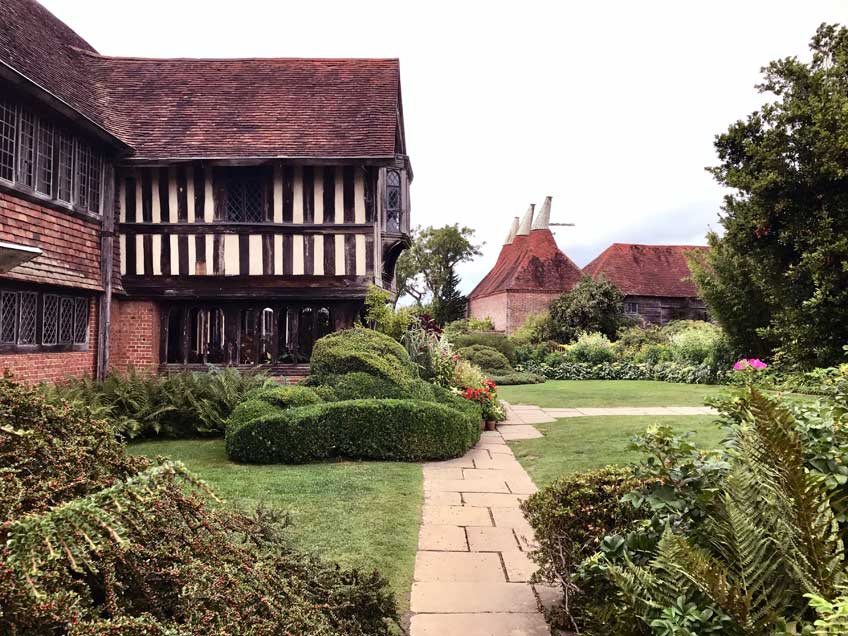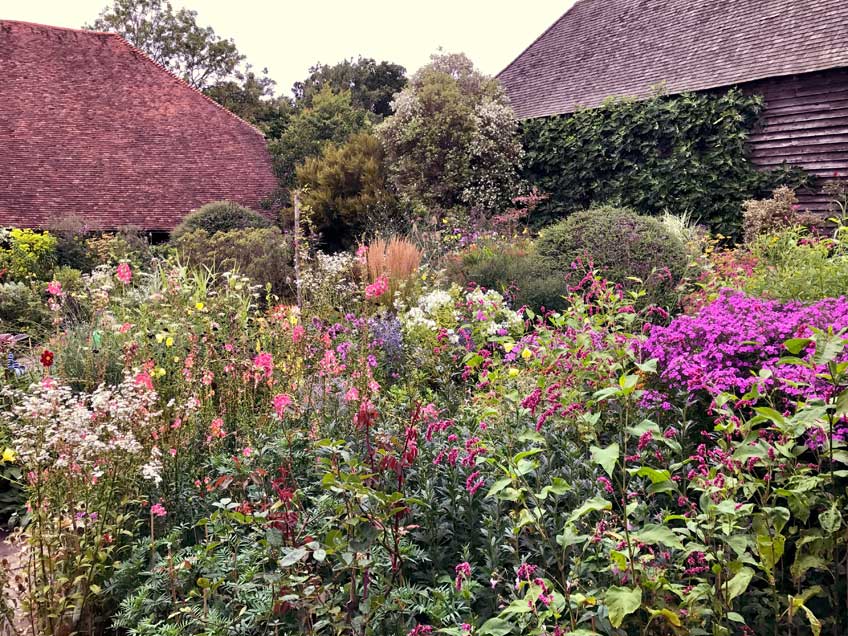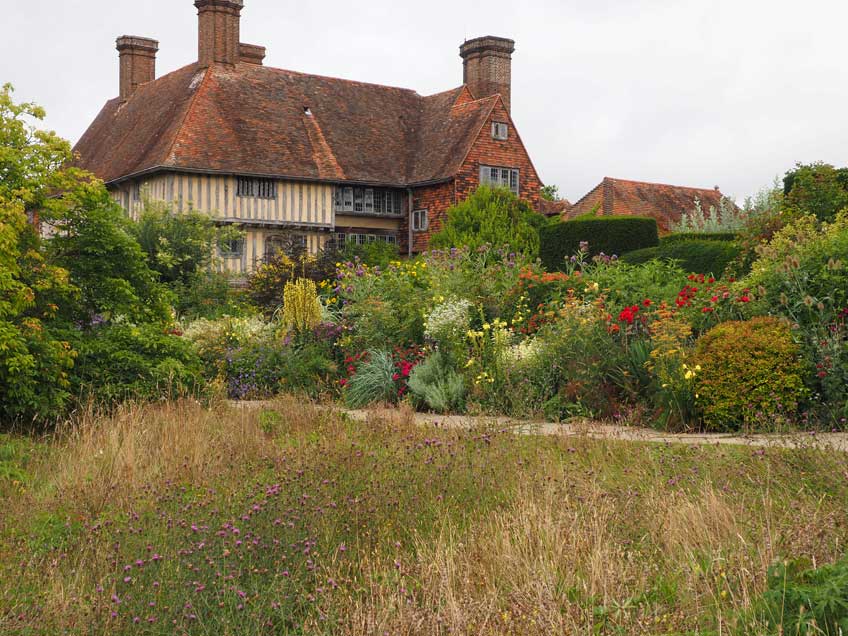Is this old place England’s most exciting contemporary garden?
Great Dixter takes the charming English flower garden and dials it up to 11. It is overwhelming and boisterous, mad and loud, and more densely packed with plants than anywhere I’ve ever been.

Words and pictures: Robin Powell
The marvel starts with the house itself, an odd assortment of rooms built over a half-timbered Tudor manor with mullioned windows and steep gables, whose
portico leans so severely off the horizontal that it seems to defy gravity. In front of the house a tide of potted plants washes toward you. Not just
a pot or three, but a dozen or more on each side of the entrance, the rare and overly familiar mixed like a painting of tone and texture, with each
plant replaced the minute it’s not up to the show.

Daring and wit
Christopher Lloyd was born in the house in 1921 and lived there all his life. He was a gardener and garden writer with strong opinions and a fabulous sense
of style, who gardened with wit and daring. His father too had been a keen gardener, and, with architect Edward Lutyens laid out the yew hedges, wide
terraces and flagstone paths that still form the bones of the garden.
Lloyd was an enthusiastic, and unsentimental, experimenter whose daily walks around the garden spelled doom for underperformers. Every plant was severely
judged on its individual performance and its contribution to the whole. His lack of sentiment sent garden conservatives into a frenzy in the 1980s
when he pulled out the historic rose garden and replaced it with exotic tropical plants. It’s now a cooling tapestry of primarily foliage plants, with
greens and splashes of purple from bananas and cannas, sugar cane and alocasia. The long arching canes of a single pink rose are a reminder of the
garden’s history.
Lloyd’s iconoclasm is also evident in the topiary garden where the clipped yew forms now look more like daleks than the castles and peacocks of their Edwardian
origins. They contrast serenely with a wild meadow planting that is dense with native orchids in early spring and interspersed with continuous flowering
in mid-summer in blurry, transparent plumes the same colour as the old terracotta on the roof tiles.

Degree of difficulty
Since Christopher Lloyd’s death in 2006, Dixter’s fame has only grown. Its reputation is due to the incredible talents of head gardener Fergus Garrett,
who started working with Lloyd in 1994. Garrett is one of the leading plantsman of his generation, renowned for his knowledge, and his generosity in
sharing it. It was Garrett who first introduced that expansive arrangement of pots at the front door, but it is in the pool garden that visitors get
their first true taste of Garrett’s form of Dixter-magic.
I stepped first through a narrow gap in a dark yew hedge into the pool garden and burst out laughing. Suddenly I was surrounded by flowers. The paths were
narrowed by exuberant plants that softly barred my passage, tickled my arms and bent their flowers to my face. Colours and forms washed together, dots
of contrast bringing out the richness of softer tones, as in a painting by Monet. If the flowers were the canvas, the frames were the beautifully aged
rooves and walls surrounding it - moss-covered tiles, lichen-patterned stone, silvered and charcoaled wood.

It is these built elements that confine and make sense of the planting all through the garden. At some points the growth is so high around you that all
you can see are the chimneys rising from the undulating ridge of the roof. The dynamism of the planting extends over the whole of the growing season.
Garret is a master of succession planting, so that one thing follows another in tides of growth well into the autumn. The Long Border, framing views
of the house, is the piece de resistance, where structural plants, perennials, self-sown annuals, interplanted and underplanted bulbs, pockets
of bedding and clever use of climbers provide an extraordinarily long show.
Lloyd himself wrote that “It is my belief that no gaps, showing bare earth, should be visible from late May on, apart from the most recent replacement
plantings. The effect should be of a closely woven tapestry... For all the work that goes into it, I want the border to look exuberant and uncontrived.”
And it does! The dynamism of Great Dixter brings young and passionate gardeners from all over the world to work with Garrett and learn from his expertise
and the great lessons buried in the garden itself.The evidence of their hard work is everywhere you look. This is the very antithesis of low-maintenance
gardening. The degree of difficulty is enormous and the work required to pull it off is awe-inspiring. You’ll feel like giving it a round of applause
and a standing ovation.
